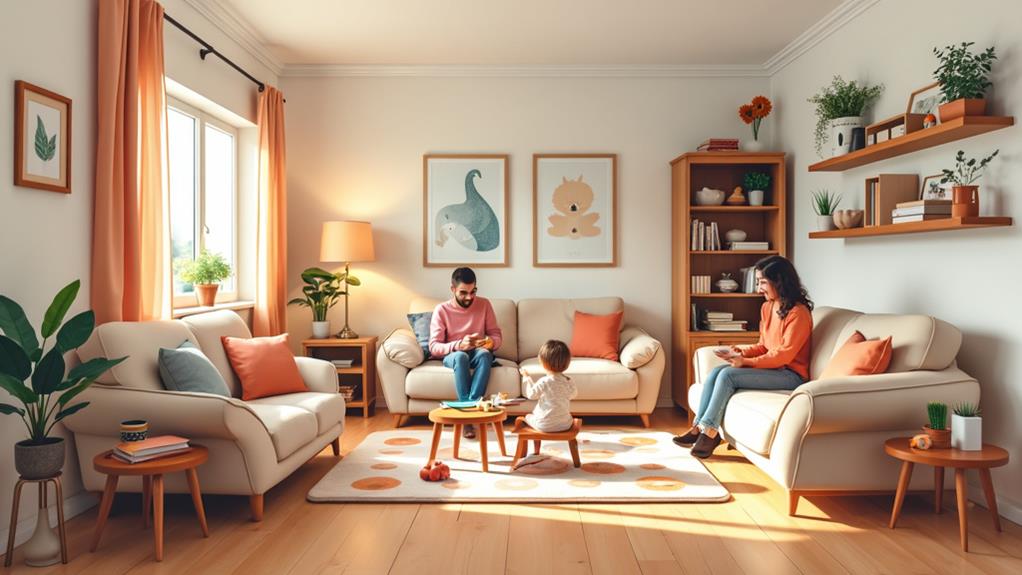Kid-proof layouts are a smart choice for families, focusing on safety, accessibility, and adaptability. We prioritize non-toxic finishes, secure heavy items, and use rounded furniture corners to prevent accidents. Wide pathways and built-in storage reduce tripping hazards, while specific zones for play, study, and relaxation keep spaces organized. Durable, easy-to-clean materials like hardwood and stain-resistant fabrics guarantee longevity. Incorporating multi-functional furniture, such as sofa beds and coffee tables with storage, maximizes utility. By optimizing layouts to evolve with children's changing needs and integrating technology effectively, we create functional and engaging environments. To learn about specific strategies, let's explore further.
Understanding Kid-Friendly Layouts
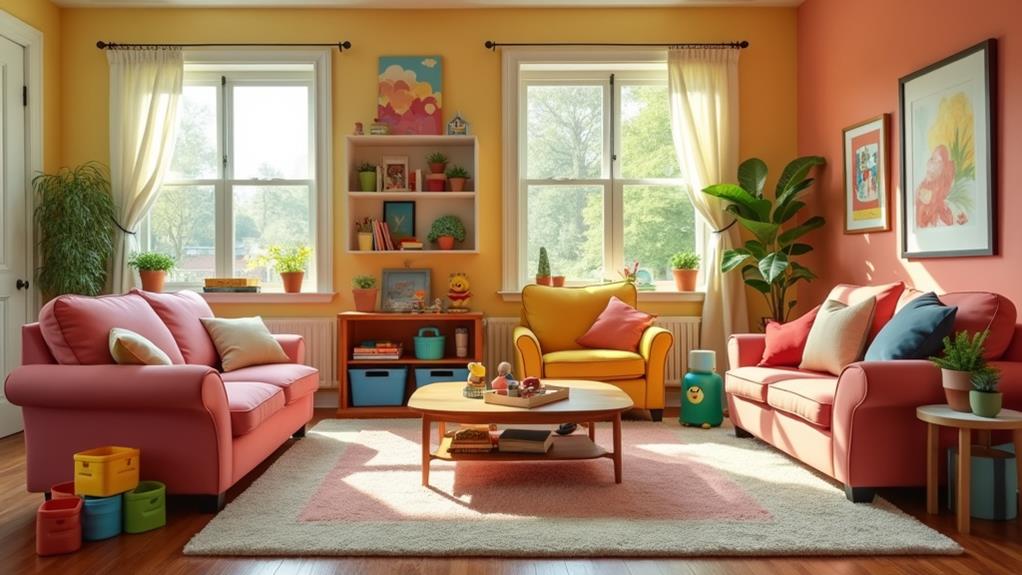
When it comes to creating kid-friendly layouts, we need to prioritize safety, accessibility, and engagement. These elements guarantee that our spaces not only look welcoming but also function effectively for children's needs.
We can start by considering the flow of movement within a room. Wide pathways allow easy navigation and minimize the risk of tripping or bumping into furniture. Additionally, placing frequently used items within a child's reach fosters independence and reduces the need for adult assistance.
In terms of engagement, incorporating interactive elements into the design can be highly beneficial. For instance, including a designated play area with educational toys encourages both physical activity and cognitive development. Bright, cheerful colors and visually stimulating patterns can also capture children's attention and spark creativity.
Moreover, choosing durable and easy-to-clean materials is essential. Kids are naturally prone to spills and messes, so surfaces that can withstand heavy use and are simple to maintain will save us time and effort in the long run.
Prioritizing Safety in Furniture
Guaranteeing the safety of our furniture is essential when designing spaces for kids. We must consider both the materials and the construction of each piece. Opting for non-toxic finishes and sturdy builds can prevent numerous accidents.
Sharp edges pose significant risks for young children prone to falls and bumps, so rounded corners on tables, chairs, and other furniture are vital. Additionally, securing heavy items such as bookshelves and dressers to the wall can avert potential tipping hazards.
Storage benches with practical seating and organization can help manage clutter effectively, keeping toys and other items off the floor and reducing tripping hazards.
We should also be mindful of the placement of furniture. Avoid putting climbable objects near windows to prevent falls, and make sure that cords from blinds or electronics are out of reach to reduce strangulation risks.
Furniture with built-in storage can help keep toys and other items off the floor, reducing tripping hazards.
Maximizing Space With Smart Arrangement
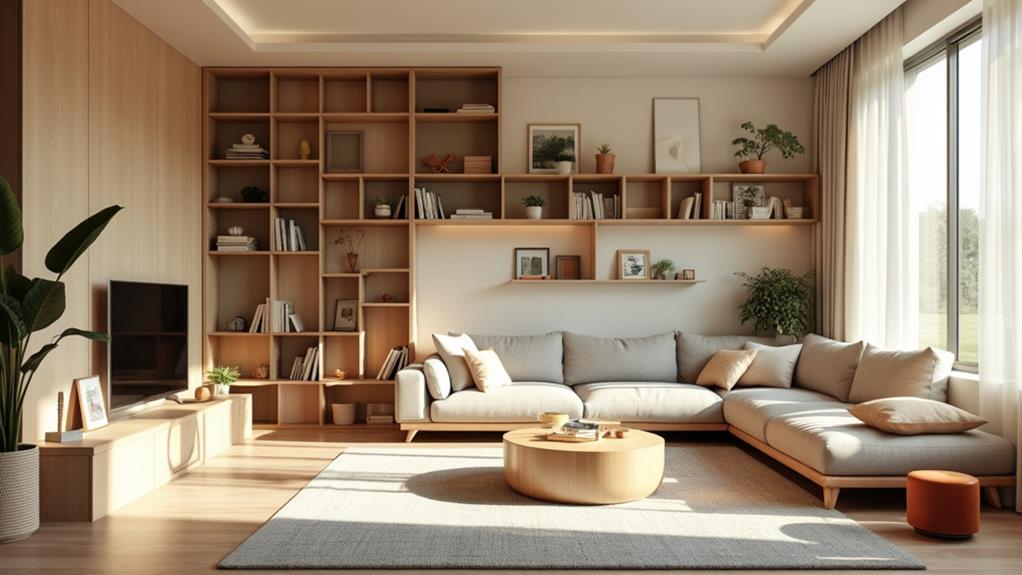
Maximizing space in a kid-friendly environment requires a strategic approach to arrangement. We need to examine the layout carefully to guarantee every square foot serves a purpose, balancing functionality with ease of movement.
One effective technique is to create clearly defined zones for different activities, such as play, study, and relaxation. By allocating specific areas for each function, we can keep the space organized and prevent clutter from spreading throughout the home.
Utilizing vertical space is another essential strategy. Shelving units and wall-mounted storage solutions can free up floor space, making the room feel more open and spacious. Additionally, placing commonly used items within easy reach for children can promote independence and reduce the need for constant supervision.
Incorporating ergonomic seating can also enhance comfort and support for study zones.
Another method involves arranging furniture to facilitate smooth traffic flow. Placing larger pieces against the walls can open up central areas for play or other activities. It's also wise to leave ample space between furniture to avoid potential tripping hazards and to guarantee that children can move around freely and safely.
Incorporating Multi-Functional Furniture
How can we make the most out of every piece of furniture in a kid-friendly space? Multi-functional furniture is the key. Pieces that serve more than one purpose can maximize utility, especially in spaces shared with children.
For instance, consider a sofa bed. It provides seating during the day and transforms into a sleeping area at night, accommodating guests without the need for a separate guest room. Similarly, a coffee table with built-in storage offers a place for beverages and snacks while also hiding away toys or books.
For a stylish option, the Ariella Coffee Table can serve as both a centerpiece and a storage solution.
Another excellent option is a dining table that doubles as a homework station. With drawers or compartments, it can store school supplies, making shifts between meal times and study sessions seamless.
Bunk beds are also a practical choice, freeing up floor space for play while providing sleeping quarters for multiple children.
Additionally, ottomans with hidden storage can serve as footrests, extra seating, or even a makeshift play table.
Integrating Storage Solutions
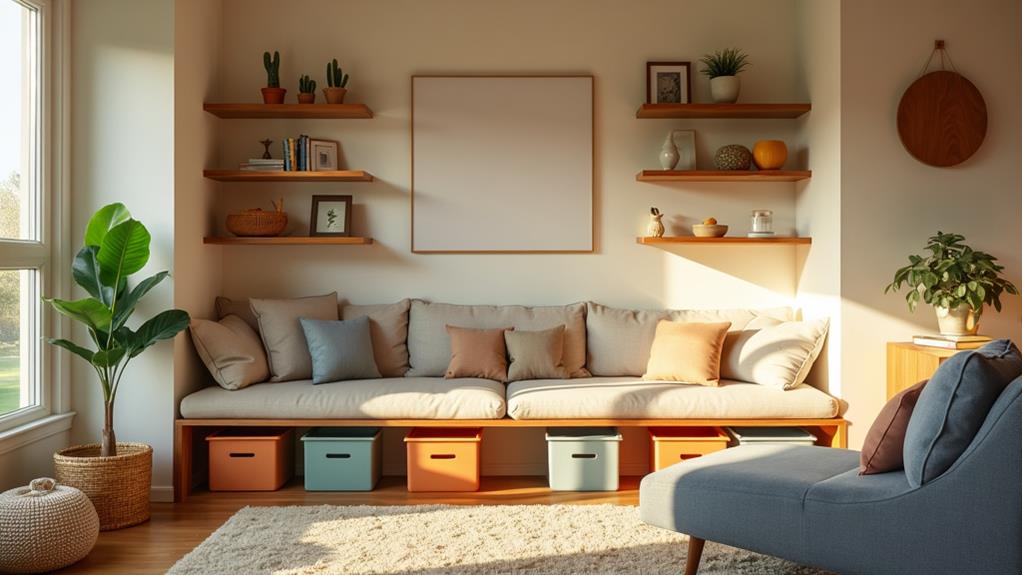
Integrating storage solutions seamlessly into our kid-friendly spaces is just as important as selecting multi-functional furniture. Efficient storage not only maximizes space but also promotes organization, making it easier to maintain a tidy environment amidst the chaos of family life.
By incorporating built-in shelving, under-bed drawers, and wall-mounted units, we can guarantee that toys, books, and other items have designated places, reducing clutter and improving accessibility.
Think about creating zones within a room, where different activities have their own storage areas. For instance, a reading nook could feature low shelves for books and a small basket for toys, while an art corner might include wall-mounted bins for supplies.
Vertical storage is particularly useful in smaller spaces, as it utilizes otherwise wasted wall space and keeps items within easy reach for children.
Additionally, labeling storage bins and baskets can help kids learn where things belong, fostering independence and responsibility. Clear containers allow quick identification of contents, saving time during cleanup.
Choosing Durable Materials
When designing kid-friendly spaces, it's crucial to choose durable materials that can withstand the daily wear and tear of family life. We need to prioritize materials that aren't only robust but also easy to maintain.
For flooring, consider options like hardwood, tile, or luxury vinyl planks, which are resistant to scratches and spills. These materials can handle the rough-and-tumble activities that accompany young children and offer the added benefit of being easy to clean.
In terms of furniture, we should look for pieces made from solid wood or metal, as these materials tend to hold up well under pressure. Upholstered furniture should feature stain-resistant fabrics or removable, washable covers. Leather is another excellent choice due to its durability and ease of cleaning, though it may require some upkeep to maintain its appearance.
For countertops, quartz and granite are both excellent choices because they're non-porous and resistant to stains and scratches.
In high-traffic areas, we might want to use semi-gloss or satin paint finishes on walls, which can be easily wiped down without showing too many marks.
Adapting Layout as Kids Grow
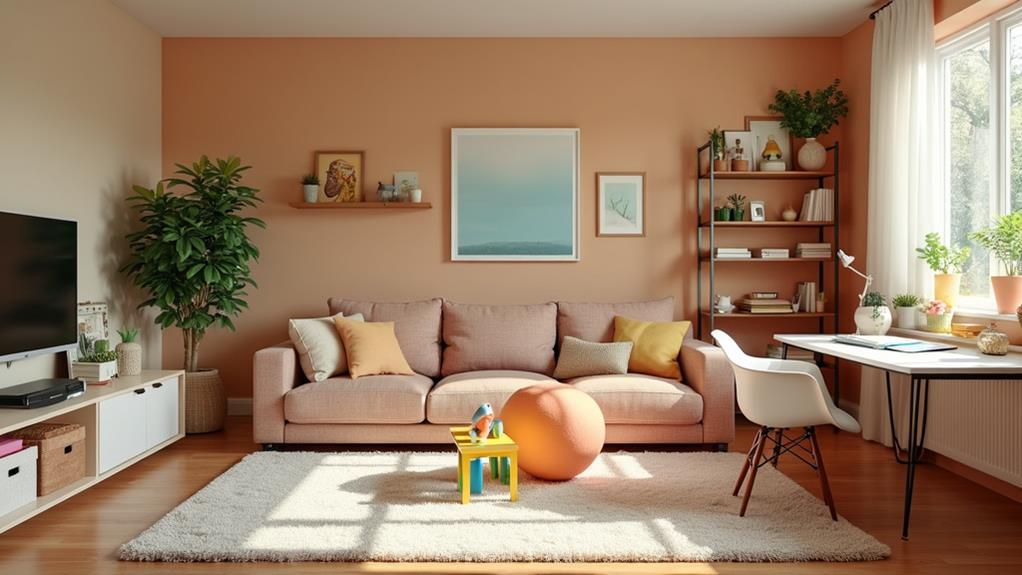
As our kids grow, adapting the layout of our home becomes essential to accommodate their changing needs and interests. Initially, safety is our primary concern, necessitating childproof locks, gates, and soft corners.
However, as children age, their requirements shift, and our spaces must evolve accordingly.
For young children, play areas with ample storage for toys and books are important. Open floor plans can facilitate supervision, allowing us to keep an eye on them while they play.
As they enter school age, creating designated homework or study areas becomes critical. These spaces should be quiet, well-lit, and equipped with necessary supplies, fostering a conducive environment for learning.
Teenagers demand more privacy and independence. It's ideal to transform shared spaces into individual rooms if possible.
Functional furniture that doubles as storage can help manage their growing collection of personal items. Additionally, integrating technology-friendly zones becomes increasingly significant, providing them with areas for their devices, charging stations, and comfortable seating for social interactions.

